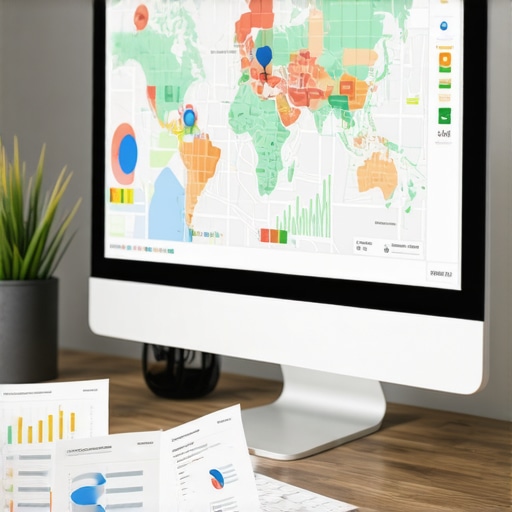Unlocking the Power of GeoGrid Tracking: A Strategic Paradigm for Local SEO Domination
In the rapidly evolving landscape of local search optimization, the integration of GeoGrid tracking techniques has emerged as a cornerstone for businesses aiming to outperform competitors on Google Maps. This sophisticated approach leverages spatial data analytics and cutting-edge GMB software to meticulously monitor and enhance map rankings, thereby translating geographic insights into tangible visibility gains.
Strategic Significance of GeoGrid Mapping in Google Maps SEO
GeoGrid mapping involves partitioning targeted areas into precise geographic cells, enabling granular analysis of ranking fluctuations. When combined with advanced GMB software, it facilitates real-time tracking of position shifts, revealing patterns that inform tactical adjustments. This method is especially potent in hyper-local markets where competitive density demands nuanced strategies.
Why Traditional Local SEO Tactics Fall Short Without GeoGrid Precision
Conventional approaches often overlook the spatial variability within target zones, risking generic campaigns that lack contextual relevance. The application of GeoGrid strategies addresses this gap by providing spatially explicit performance metrics, which are crucial for identifying micro-areas requiring targeted interventions. This refined focus enhances the effectiveness of local citations, reviews, and on-page SEO.
Expert Insights: How to Leverage GeoGrid Data for Optimal Rankings
Professionals in local SEO utilize GeoGrid tracking to analyze ranking variability across different cells, correlating data with user behavior and competition density. By doing so, they can tailor their content, backlink profiles, and citation strategies to specific areas, ensuring a higher likelihood of visibility in the most competitive zones. This approach transforms raw spatial data into actionable insights.
What are the most effective metrics to monitor in GeoGrid-based tracking systems for sustained Google Maps ranking improvements?
Focusing on metrics such as rank volatility within cells, local review velocity, and citation consistency across geographic segments allows for a comprehensive understanding of ranking dynamics. Incorporating expert tips from seasoned practitioners can further refine your tracking and optimization strategies.
For those seeking to deepen their mastery, exploring GMB software innovations and their role in GeoGrid analysis is invaluable. As the field advances, staying informed through authoritative sources ensures your techniques remain cutting-edge.
Interested in elevating your local SEO game? Engage with industry peers, share insights, and contribute to the evolving discourse on professional forums. The future of Google Maps ranking mastery hinges on continuous innovation and strategic application of spatial analytics.
Expanding Your GeoGrid Tactics: Integrating AI and Machine Learning for Next-Level Local SEO
As the landscape of local SEO continues to evolve, the integration of artificial intelligence (AI) and machine learning (ML) with GeoGrid tracking offers unprecedented opportunities for precision and insight. By leveraging AI-driven algorithms, businesses can analyze vast amounts of spatial and behavioral data to predict ranking fluctuations and identify micro-areas ripe for optimization. This fusion of technology not only refines existing strategies but also uncovers hidden opportunities in hyper-local markets.
The Power of Predictive Analytics in GeoGrid Mapping
Predictive analytics, fueled by ML models, enables SEO professionals to forecast how changes in reviews, citations, or user engagement might impact rankings within specific cells. For instance, by analyzing historical data patterns, an ML system can recommend targeted interventions before ranking drops occur, thus maintaining a competitive edge. To implement such advanced techniques, understanding the underlying data structures and continuously refining your models is critical. For practical guidance, exploring cutting-edge GMB software tools that incorporate ML capabilities can accelerate your success.
What innovative algorithms can be integrated into GeoGrid tracking to proactively manage local search rankings?
Adopting algorithms such as Random Forests or neural networks can help predict ranking shifts with higher accuracy. These models analyze factors like review velocity, proximity, and user engagement, offering actionable insights that traditional analysis might miss. Implementing such predictive models requires a solid understanding of data science principles, but the payoff is a dynamic, adaptive strategy that keeps your business ahead of the curve. For deeper insights, visit expert tips on advanced tracking techniques.
Engaging with industry peers through forums and case studies can provide real-world examples of successful AI integrations in GeoGrid strategies. Sharing your own experiments and results fosters community learning and innovation, vital for staying competitive in 2024’s fast-changing environment.
Enhancing Data Collection: The Role of IoT and Sensor Data in Hyper-Local Optimization
The proliferation of Internet of Things (IoT) devices and sensor data presents new avenues for hyper-local SEO refinement. By harnessing real-time data from sensors—such as foot traffic counters, environmental sensors, or smart city infrastructure—businesses can fine-tune their GeoGrid strategies based on actual movement patterns and environmental factors. This granular data allows for micro-targeting in areas that traditional methods might overlook, boosting visibility precisely where it matters most.
For example, a restaurant could use foot traffic data to adjust its marketing efforts in the most active cells, or a retail store might optimize its Google My Business profile based on environmental factors affecting customer visits. To explore how these innovative data sources can be integrated into your GeoGrid plan, visit comprehensive tracking strategies.
Harnessing the Power of Multi-Layered GeoGrid Analysis for Hyper-Local Market Mastery
Expanding on foundational GeoGrid mapping, sophisticated practitioners are now integrating multi-layered spatial analysis that combines demographic, behavioral, and environmental data within each geographical cell. This multidimensional approach enables a more nuanced understanding of consumer patterns, competition density, and environmental influences, which are critical in hyper-competitive markets. By overlaying data such as income levels, foot traffic intensity, and weather conditions onto the GeoGrid framework, businesses can refine their local SEO strategies to an unprecedented degree of precision.
Implementing such layered analysis requires advanced GIS tools and data integration platforms. These systems facilitate the visualization of complex data sets, revealing micro-trends and micro-competition zones that traditional single-layer GeoGrid analysis might miss. For example, a retail chain could identify specific cells with high foot traffic but low competitor presence during certain times of day, enabling hyper-targeted promotional campaigns that maximize footfall and conversions.
Moreover, leveraging cloud-based spatial data warehouses and APIs allows for real-time updates and dynamic strategic adjustments. As environmental and demographic patterns shift, businesses can instantly recalibrate their focus, ensuring sustained dominance in local search results. This approach exemplifies the integration of spatial intelligence with advanced analytics, transforming local SEO from reactive to proactive and predictive.
Harnessing Multi-Dimensional Spatial Data for Micro-Targeted SEO Success
Building upon foundational GeoGrid techniques, innovative practitioners are now integrating multi-layered datasets—such as socio-economic demographics, traffic flow analytics, and environmental variables—within each geographic grid cell. This multidimensional approach enables a granular understanding of market dynamics, allowing for hyper-targeted SEO interventions that outperform traditional methods. By overlaying real-time data streams from sources like urban sensors and social media check-ins, businesses gain unprecedented insight into micro-trends, facilitating dynamic strategy adjustments that keep them ahead in local search rankings.
What Cutting-Edge Technologies Are Powering Next-Gen GeoGrid Analysis?
Emerging technologies such as Geographic Information System (GIS) platforms integrated with artificial intelligence (AI) and machine learning (ML) are revolutionizing spatial analysis. These tools automate the identification of high-potential micro-areas, optimize resource allocation, and predict ranking fluctuations with remarkable accuracy. For example, AI-driven heatmaps can visualize areas of increasing consumer activity, guiding businesses to focus their SEO efforts precisely where it matters most. Leveraging such sophisticated platforms requires deep technical expertise but offers a competitive edge in hyper-local markets.
How Can Predictive Analytics Transform Your Hyper-Local SEO Framework?
Predictive analytics, powered by advanced ML models, enable SEO strategists to forecast ranking trends based on historical and real-time data inputs. This proactive approach allows for strategic preemptive actions—such as timing review campaigns, adjusting citation distributions, or deploying targeted ad spend—to mitigate potential drops and capitalize on emerging opportunities. For instance, analyzing foot traffic fluctuations linked with weather patterns or event schedules can help refine geo-targeted marketing efforts with surgical precision. For authoritative insights, consult industry-leading sources such as the Esri GIS platform, renowned for its spatial analytics capabilities.
What are the most advanced algorithms integrating spatial and behavioral data for predictive local SEO?
State-of-the-art algorithms like convolutional neural networks (CNNs) and ensemble learning models, including Random Forests, are increasingly employed to analyze complex spatial and behavioral datasets. These models can identify subtle patterns and micro-trends, enabling proactive optimization of Google My Business profiles and local citations. Implementing such algorithms demands expertise in data science and spatial analytics but yields highly adaptive strategies that dynamically respond to evolving local landscapes. Explore resources like Databricks’ ML workflows for integrating these advanced techniques.
Engaging with professional communities on platforms such as LinkedIn or specialized GIS forums accelerates knowledge exchange and innovation. Sharing case studies and success stories fosters a collective advancement in hyper-local SEO mastery.
Integrating IoT and Sensor Data: The Future of Hyper-Localized Optimization
The proliferation of Internet of Things (IoT) devices—ranging from smart foot traffic counters to environmental sensors—opens new horizons for real-time, hyper-local SEO refinement. Businesses can harness this data to dynamically adjust their Google My Business profiles, promotional campaigns, and service offerings based on actual movement patterns and environmental conditions. For example, a retail store could increase visibility efforts during peak foot traffic hours identified through sensor data, maximizing conversion potential. To explore this frontier, consult comprehensive guides such as IoT integration strategies.
The Synergy of Spatial Intelligence and Behavioral Analytics in Hyper-Local Markets
By combining spatial intelligence with behavioral analytics—such as purchase history, online engagement patterns, and social media activity—businesses can craft hyper-personalized marketing strategies that resonate at a micro-geographical level. Layering this data within a multi-dimensional GeoGrid framework enables a nuanced understanding of customer preferences, competition, and environmental influences. Implementing cloud-based spatial data warehouses and real-time API feeds facilitates continuous strategic recalibration, ensuring a dominant presence in local search results amidst ever-changing market conditions. This sophisticated integration marks the frontier of local SEO, where proactive, data-driven decisions define success.
Expert Insights & Advanced Considerations
1. Multi-Source Data Integration Enhances Precision
Leveraging diverse data streams such as IoT sensors, social media check-ins, and environmental metrics allows for hyper-local SEO strategies that are both proactive and reactive, ensuring competitive advantage in dense markets.
2. AI and Machine Learning Drive Predictive Accuracy
Integrating advanced algorithms like neural networks and ensemble models facilitates the anticipation of ranking shifts, enabling businesses to optimize their GMB profiles and citations dynamically, effectively staying ahead of the curve.
3. Multi-Layered Spatial Analysis Unveils Hidden Opportunities
Overlaying demographic, behavioral, and environmental data within a multi-dimensional GeoGrid framework provides a nuanced understanding of market dynamics, leading to micro-targeted SEO interventions with maximum impact.
4. Real-Time Data Utilization Ensures Agility
Employing real-time spatial and sensor data allows for instant adjustments to marketing tactics, maximizing visibility during peak foot traffic periods and environmental conditions, thus enhancing local engagement.
5. Advanced Analytics Platforms Are Game-Changers
Utilizing GIS platforms integrated with AI/ML capabilities, such as Esri or Databricks, empowers SEO professionals to automate high-potential area identification, resource allocation, and ranking prediction with remarkable precision.
Curated Expert Resources
- https://geogridranker.com/unlock-the-power-of-maps-rank-with-advanced-gmb-software: A comprehensive guide on using cutting-edge GMB software for spatial rank analysis and optimization.
- https://geogridranker.com/geogrid-tracking-strategies-to-dominate-local-search-results: Techniques for implementing GeoGrid strategies to outperform competitors in local search.
- https://geogridranker.com/mastering-geogrid-tracking-boost-your-maps-rank-effectiveness: Advanced methods to elevate map rankings through precise GeoGrid tracking.
- https://geogridranker.com/supercharge-your-local-visibility-using-gmb-software-and-geogrid-tracking: Strategies combining software tools and GeoGrid analytics for maximum local visibility.
- https://geogridranker.com/how-geogrid-maps-tracking-can-revolutionize-your-local-rankings: Insights into transforming local SEO efforts with innovative mapping techniques.
Final Expert Perspective
In the realm of local SEO, mastering GeoGrid tracking represents a paradigm shift from reactive to proactive strategies, empowering businesses to harness spatial intelligence and predictive analytics for sustained dominance. By integrating multi-source data, employing sophisticated AI algorithms, and leveraging powerful GIS platforms, professionals can unlock unprecedented levels of precision and agility. As this field continues to evolve rapidly, engaging with authoritative resources and sharing insights within expert communities will be vital for maintaining a competitive edge. To deepen your expertise, explore the recommended tools and strategies, and consider contributing your own experiences to the collective knowledge pool—because in this game, continuous innovation is the ultimate advantage.
,

